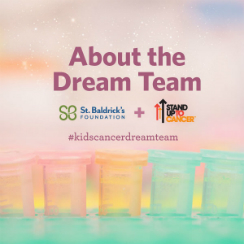Formerly known as the St. Baldrick’s – Stand Up to Cancer Pediatric Cancer Dream Team, this team is now the St. Baldrick’s EPICC Team (Empowering Pediatric Immunotherapies for Childhood Cancer).

Curative chemotherapy for cancer was first realized in children. Survival rates for many of the common cancers in children improved dramatically through the last part of the 20th century. However, those cure rates have plateaued since the 1990s, and for some childhood cancers, we have seen little to no improvements.
Furthermore, we are keenly aware that our current therapies can’t win the battle against childhood cancer when they often lead to side effects that reduce the quality of life for our young patients as they grow into adulthood. We need new kinds of therapeutics if we are to improve survival of children with cancer and decrease the financial, emotional, and life-altering costs of curative therapies.
Investigators on our team have used new technologies in the field of cancer genomics to discover the fundamental basis for the most aggressive childhood cancers. These studies have provided new insights into biology, but have not yet revolutionized therapies.
In parallel, investigators on our Team have also led efforts to harness the body’s own immune system to eradicate cancer. Stunning recent advances in this field have resulted in unmatched enthusiasm for immunotherapy as a potent new weapon in the fight against childhood cancer, but these therapies remain limited in application, available only for a few disease types and in very few institutions.
Shockingly, the fields of cancer genomics and immunotherapy have come to age separately, with essentially no cross-fertilization and little collaboration.
We propose to bring together the fields of genomics and immunotherapy through a collaborative project focused on developing new, targeted immunotherapies for the most difficult to cure childhood cancers. These include:
- high-risk neuroblastoma
- sarcomas (osteosarcoma, Ewing sarcoma, rhabdomyosarcoma)
- brain tumors
- acute myeloid leukemia
- refractory (resistant to treatment) acute lymphoblastic leukemia
Our vision is that we will accelerate progress by bridging the gaps between genomics and immunology with emphasis on three major principles:
Scientific cross-fertilization: Experts in the fields of genomics and immunotherapy will work together as a cohesive team to collaboratively develop new areas of research focus. This will include basic, translational, and clinical research.
Concentrated focus: Our multidisciplinary team will focus on the discovery of cell surface molecules on pediatric cancers that can be targeted using antibody-derived binding proteins and develop new therapeutics based upon this targeting element.
Clinical trials consortium: Real advances using these new treatments will require the ability to conduct large-scale studies of these therapies at many children’s hospitals throughout North America. Thus, the Dream Team will distribute studies across its member institutions, as a first step toward ultimately exporting these new therapies to other institutions.
Dream Team members are from the following institutions:
- Children’s Hospital of Philadelphia
- National Cancer Institute
- Texas Children’s Hospital /Baylor Medical School
- Seattle Children’s Hospital
- University of British Columbia
- Hospital for Sick Children (Sick Kids, Toronto)
- University of Wisconsin
We are at a crossroads in our quest to conquer childhood cancer. This Dream Team will bring together the two most promising arenas in childhood cancer today to potentially revolutionize the treatment of childhood cancer.
Be a part of the revolution in childhood cancer treatment — make a donation today.

 SBF
Tweets »
SBF
Tweets »